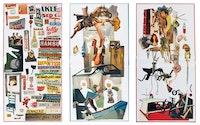What is to be done with histories that are marked and marred by systems of oppression? While there is a growing movement for the removal of public monuments that have long served as emblems of white and male supremacy, the question of how to approach and appreciate what those old things textbooks once called “monuments of art history” is more problematic. Inside the museums, recontextualization rather than removal seems to be the order of the day, but it is not entirely clear if new juxtapositions are enough to engender new values from a canon that is fundamentally predicated on the objectification and the marginalization of women and people of color. Can artists who reject such values work their way out of these traditions without drawing upon institutions, innovations, and iconography of the past which, to a certain extent, serve as indispensable conventions that ground an object’s very identity as art?
This question runs through the 65 photocollages in Justine Kurland’s show SCUMB Manifesto. Riffing on Valerie Solanas’s 1967 feminist broadside announcing “the society for cutting up men” (SCUM), Kurland’s project adds a silent B to indicate that, here, it is men’s books that are being cut up. Kurland’s collages can be seen as summoning the feminist utopia Solanas imagined, one in which the elimination of men would augur a more peaceful, creative, and empathic society. The untidy and oftentimes humorous world pictured in the works captures both the emancipatory madness and violent stridency of Solanas’s radical vision, which notoriously led her to shoot Andy Warhol in 1968.
olanas reportedly told the police officer who she turned herself into that Warhol “had too much control in my life.” It is likewise possible to see the male artists whose photobooks serve as both the source imagery and material support for Kurland’s collages as similarly domineering forces that the artist seeks to subvert through an equally destructive, albeit aesthetically circumscribed, act. Kurland ransacked her collection of photobooks to create these collages, using the bindings of each volume as the surface upon which to glue various fragments, so that the dimension of each collage (with the exception of the floral vortex of pussies and leggy asses made from one of Lee Friedlander’s books of nudes) are determined by the contours of the book from which the sources imagery is taken. In certain cases, the color of the boards and endpapers becomes a crucial aesthetic component, as in the triptych of collages made from William Eggleston’s Los Alamos, in which the exposed edges of each volume set the tone for the pieces constructed from the photographer’s much-admired color images. In many of Kurland’s collages, the book’s spine, with its torn nubs of paper, takes on the corporeal connotations of its name, underscoring the numerous disjointed and damaged bodies that populate these works.
Not surprisingly, women’s bodies are a frequent subject and along with Friedlander, Edward Weston, Guy Bourdin, and, perhaps most expectedly, Helmut Newton all get the razor’s treatment, pinpointing their apparent fascination with breasts, genitals, and female flesh more generally. Drawing upon the cut-up technique’s capacity to reveal subterranean messages, Kurland exposes the manic fetishization of Alfred Stieglitz’s focus on Georgia O’Keeffe’s hands, and even less sexually charged material, like Chauncey Hare’s, for example, shows its author to be something of a leg man. Likewise, many of the collages hit on stylistic cliches associated with each master—Robert Adams’s meticulous architecture, Ralph Eugene Meatyard’s masks, Stephen Shore’s plates of food—and for viewers well versed in the history of the photobook part of the fun is trying to identify the artist through these fragmentary signs of authorial presence. (The titles of the collages only give the book’s titles and not the names of their creators).
Turning mass produced books into unique artworks, Kurland’s act of iconoclasm doesn’t have the same shock value as Jake and Dinos Chapman’s puerile amendments to Goya’s Disasters of War. Yet it is hard to not recognize Kurland’s engagement with the escalating market for photobooks as collectable objects in their own right. While it appears that the artist’s library tends toward reprints rather than first editions, many of the destroyed books are nonetheless quite expensive. For instance, Philip-Lorca diCorcia’s Hustlers, of which two copies were plundered by Kurland, goes for around $450 these days—which it should be noted is only half of the listed price for Kurland’s collage!
From Hannah Höch’s jampacked nightmares of Weimar culture to the trenchant exposé of the domestication of militarization of in Martha Rosler’s series House Beautiful: Bringing the War Home (c. 1967–72), photo collage has long served as a formidable means of feminist critique. Kurland’s collages, with their cyborgian figures and surreal juxtapositions, invoke these avant-garde precedents as well as more vernacular—and notably female-centered—traditions like Victorian photo collage. In this regard, Kurland’s SCUMB Manifesto expands upon her previous works that have recalibrated the decidedly masculinist traditions of the photographic road trip, depicting the childcare that figures like Friedlander and Robert Frank rarely showed, despite regularly traveling en famille. Likewise, the largely de-masculated world envisioned by these collages can be seen as darker pendants to the artist’s earlier pictures of adolescent girls posed in scenes of fantastic wildness.
Coming in the wake of the #MeToo movement, when the scumminess of men can’t be denied, Kurland’s collages appear as both indictments and salvage attempts. Disposed in wild and allusive accretions, these fragments of past artistic mastery become, when arrayed on the flayed boards of their previous containers, something like an archeological dig, or, as in the case of Passing Through Eden (2020, from Tod Papageorge’s book), a teetering garbage heap of history. This sense of a past in ruins is perhaps most vividly portrayed in the four grotesque conglomerations assembled out of Friedlander’s The American Monument. As in so many of Kurland’s collages, an animated, anarchic, even at times crude and gimmicky new world is brutally begotten from a past that is shown to be equally obscene and vicious—and, perhaps most crucially, precariously unstable.

